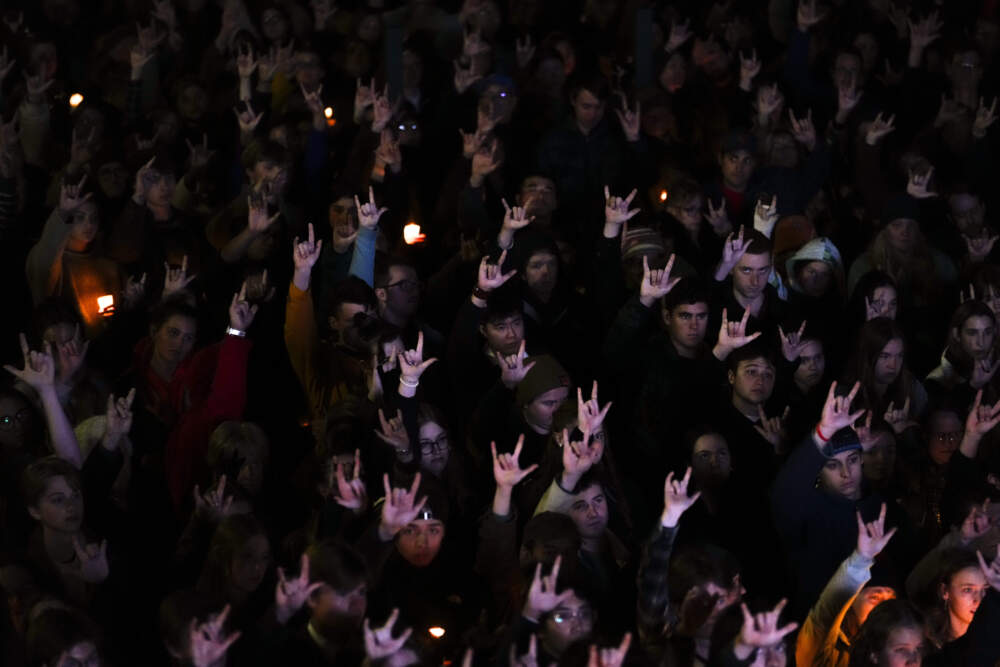Advertisement
The psychological impact of witnessing a mass shooting on youth
Resume
On Oct. 25, a gunman killed 18 people and left 13 others injured in Lewiston, Maine. The shooting spanned two locations: Just-in-Time Recreation, where a youth bowling event was underway, and Schemengees Bar and Grille.
Suspected shooter Robert Card took his own life and was found on Oct. 28 after a days-long manhunt that included a community-wide shelter-in-place order.
At the scenes of the shooting and in the following uncertainty, numerous children were at the center of this tragedy. One of the victims was 14-year-old Aaron Young.
Being directly impacted by or even witnessing gun violence has a lasting psychological impact on young people, according to research by Dr. Sandro Galea. And in the face of tragedy, community support for those children in the aftermath of violence is vital.
“Being in a supportive, warm environment that acknowledges that they've been through something difficult and that there are people around who care for them probably is the single most important thing we can do,” Galea says.
Full interview transcript:
Robin Young: Last night, more than a thousand people gathered in Lewiston, Maine, at a church, to remember the 18 friends and neighbors killed in last week's devastating mass shooting — the worst in America this year — and to comfort each other after the terror of a suspect on the loose until he apparently died of a self-inflicted gunshot wound.
We're hearing stories that as the shootings took place, there was a downtown in gridlock as texts flew, ambulances sped down streets to find survivors, parents raced to pick up kids from soccer practice, from youth night at the bowling alley where a bullet grazed ten-year-old Zoe Levesque's leg as she ran with her mother. She spoke to ABC.
(Soundbite of Zoe Levesque on ABC News: It's just, like, shocking. Like, it's something that's, you think would never happen. I never thought I'd grow up and get a bullet in my leg. Why? Like, why do people do this? I was more worried about, like, am I going to live? Am I going to make it out of here? Like, What's going to happen? Are the cops going to come?)
Young: Last weekend also saw the breaking of ground in Uvalde, Texas, to build a new school because kids can't return to the one where there was a massacre last year.
So what are the mental health consequences for kids affected by mass shootings? Dr. Sandro Galea is dean of the Boston University School of Public Health. He's done research on this. Dr. Galea, welcome.
Dr. Sandro Galea: Thank you, Robin, for having me.
Young: And we're noting, too, that this is when children around the world have been watching horrific accounts of war. So this is a frightening time, but staying with the, you know, the results of the mass shooting, what was your first thought when you saw what was happening in Lewiston?
Galea: My first thought was ‘again.’ And we know, of course, that mass shootings are only one or 2% of the total number of people who end up dying from gun violence in this country every year. So I think it's just deeply sad that we're living through this again and we know we'll live through it again. I think that's my very first thought.
Young: Well, and then your second must be, ‘I know what's going to happen here because there is research that shows, especially for children, what the impact is.’ What might parents expect?
Galea: Yeah, that's right. That is roughly my second thought, which is, you know, when these mass shootings happen, there is the immediate number of people who are immediately affected. There are obviously people who die and then there are people, some people who are injured.
And then, you end up with these long-tail consequences. And many of these long-tail consequences are psychological and these are mental health consequences that children and adults experience. Most of them are in what we would consider to be in the mood-anxiety disorder spectrum, which means things that we typically would call depression, or anxiety disorders or post-traumatic stress disorders.
And they are quite common in the people who are in the immediate environment. Less common, but also existing, in communities where these things happen. And we know that — we know this from decades of research at this point — we are going to see that, and that is going to be problematic for people who live through these events and they're going to live with these consequences for some time.
Young: And there may be things like just fear and anxiety. It's not just, in this case, the horrible shooting. And the children; It's a youth night at the bowling alley, in particular. A 14-year-old did die. But, you know, dozens of kids witnessed all of that.
We understand that children were puppy piling with their siblings in bed [with] all the family, dogs and everything. They were so frightened during the lockdown that followed. You know, it wasn't just the shooting. It was the terror of not knowing if they were safe in their own homes.
Galea: Yeah, that's right. Research, I think, is pretty clear on this. That it is the actual threat to self, threat to safety, threat to yourself and the people around you, that is ultimately associated with long-term psychological harm of these events.
And the threat to sense of safety is linked then to more longer-term psychological harm.
Young: And so, parents can expect things like that fear and anxiety: not wanting to sleep by yourself, or physical things like headaches, stomach aches. And I'm thinking this could be across the country because kids are watching this on television and on their social media.
Galea: The truth is that we are at a moment in time when there are a number of things going on around us that I think a child or a young person can reasonably feel a threat to their sense of safety. So it is certainly not implausible, and I think would be consistent with some of the published signs that people can feel threat, loss of sense of safety, even if they're watching these things from a distance.
Young: Well, talk about what helps because we understand people recover best in a community that has resources to help them.
Galea: Yeah, I think community support takes many forms. I think it starts with the parents being present and involved in the kids' lives, and making sure that the kids know that the parents are there, who care for them: primary caregivers, teachers, people who are part of the kids' normal fabric of how they interact with their school.
And then, yes, having counselors available for the kids who want to talk to them. And I think the balance here is making the resources available and creating the opportunity for the kids to use these resources without necessarily imposing them upon the kids who are needing their own time to process.
So, all of those things really matter. So being in a supportive, warm environment that acknowledges that they've been through something difficult and that there are people around who care for them probably is the single most important thing we can do.
Young: And the money to do that. You know, access. Part of access is money.
I noted an interesting observation in Scientific American, which is talking about kind of the lack of research. Here, you're somebody who's been doing some of the research, but there hasn't been as much research on the health impacts of gun violence, in part because of the 1996 law known as the Dickey Amendment, which discouraged federal funding for this kind of research. It was pushed by the gun lobby.
In 2018, Congress changed the law, permitted research into gun violence as long as it did not promote gun control, and then in 2019 money was allocated for research.
But we're sort of behind the eight-ball on the impact of mass shootings and gun violence because of that reticence, you know. How are you feeling about how there is now research coming out as we have had all these mass shootings?
Galea: I have written with colleagues about a lost generation of researchers and research around the impact of gun violence. And the reason for it was the fact that there was no federal funding for many decades, which, as you said, has now been reversed since 2018.
Although our investment in research on the consequence of gun violence remains quite small. Disproportionately small. So we are behind in terms of our understanding, but we do understand enough to know that gun violence, both mass shootings and individual gun violence, has a long-term psychological impact. Not on the majority of people, but on a substantial number of people.
And that we need to make sure that we have the resources in place to support those people, both in terms of providing the emotional practical supports that I mentioned earlier in the short term, but also to make sure that we actually have the psychological resources they can access if they need them.
Young: We're hearing in Lewiston that people there are still planning on doing their Halloween rituals for the kids in town to keep things as normal as possible. Halloween is scary. They've just had a real-life terror. Do you agree? Just keep things the way you normally would?
Galea: I generally agree. I generally agree with actually with moving things forward. I mean, I think one should approach it with some caution given the fact that Halloween happens to be a scary holiday.
But I do agree that we need to, as I said while being understanding, making sure that the kids know that there is a world around them that cares for them and is looking after them, but also encouraging them to live their lives, to move forward, to move forward in what they normally would do.
Young: That's Dr. Sandro Galea, dean of the Boston University School of Public Health. Thank you so much for speaking to us in this time. Thank you.
Galea: Thank you, Robin. Thank you for speaking about this.
Young: As we mentioned last night, the Lewiston community gathered at the Basilica of Saints Peter and Paul to grieve for the dead and say their names. Here's how some of it sounded on Maine Public.
(Soundbite on Maine Public: Maxx Hathaway. Bryan MacFarlane.)
Young: Holding candles, weeping, bowing their heads as the names of the 18 killed were read. Four deaf men were murdered. They were gathering, as they always do, once a week at Schemengees, to play cornhole. It's like horseshoes, only with corn bags that you toss through holes in a piece of wood. How innocent.
When the names of those four deaf men were read, people raised their hands, signing the American Sign Language handshape for ‘I love you.’ Religious leaders talked of hope and healing, urging them to lean on each other, and Lewiston's mayor assured the crowd the tight-knit community would be okay if they moved forward together as one Lewiston.
Gabrielle Healy produced and edited this interview for broadcast with Catherine Welch. Grace Griffin adapted it for the web.
This segment aired on October 30, 2023.

